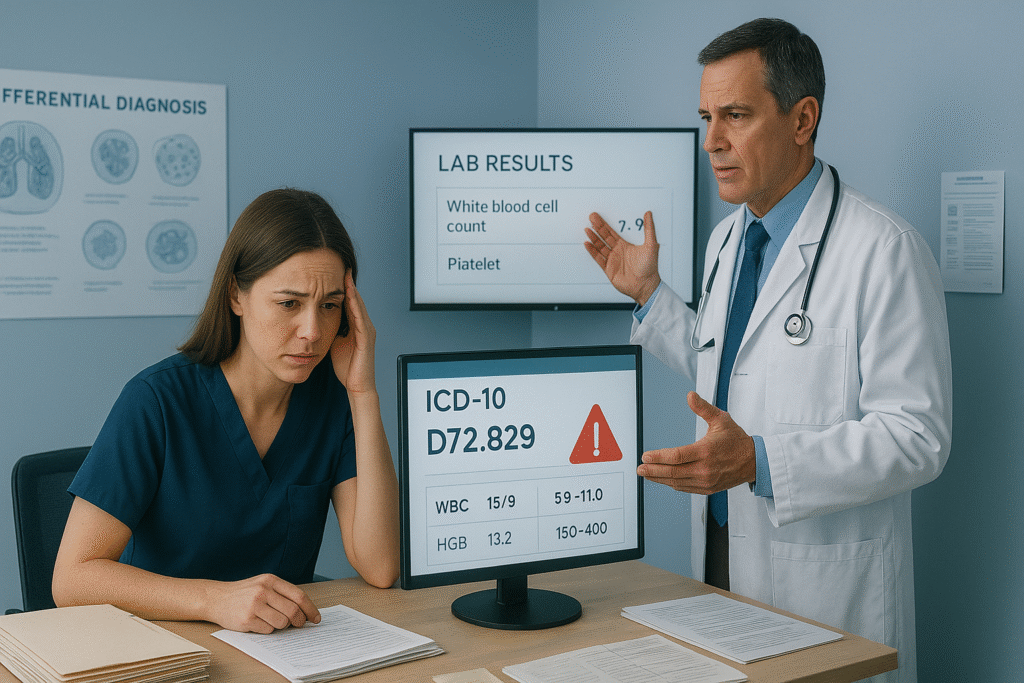
Introduction
In today’s evolving healthcare landscape, accurate documentation and coding are not just important—they’re essential. One such condition that often appears in lab results and clinical evaluations is leukocytosis, an elevation in white blood cell count. Knowing the correct ICD 10 for leukocytosis is vital for healthcare providers, coders, and billing departments alike.
This article explores the correct application of the ICD 10 for leukocytosis, breaks down the subcategories, clinical implications, and documentation tips, and provides a go-to reference for anyone working in medical coding or healthcare.
What Is Leukocytosis?
Leukocytosis is the term used to describe an increase in white blood cells (WBCs) in the blood. This condition often indicates the presence of infection, inflammation, stress, trauma, or more serious issues like bone marrow disorders or leukemia.
Although leukocytosis is not a diagnosis on its own, it is a significant clinical finding. It may warrant further investigation and must be properly documented and coded using the correct ICD 10 for leukocytosis.
ICD 10 Overview
The ICD-10-CM (International Classification of Diseases, 10th Revision, Clinical Modification) is a standardized system used to classify and code diagnoses, symptoms, and procedures. Globally, it facilitates the simplification of healthcare data tracking, billing, and reporting.
ICD 10 for Leukocytosis: Primary Code

The general ICD 10 for leukocytosis is:
D72.829 – Elevated white blood cell count, unspecified
This code is used when leukocytosis is present but the specific type of white blood cell that is elevated is not identified. It serves as a catch-all for elevated WBC findings that don’t yet have a defined subtype.
Specific ICD 10 Codes for Leukocytosis Subtypes
While D72.829 is the most widely used ICD-10 code for leukocytosis, the ICD-10 system provides more precise numbers dependent on the type of white blood cell affected:
| ICD 10 Code | Subtype Description |
|---|---|
| D72.820 | Lymphocytosis (symptomatic) |
| D72.821 | Monocytosis (symptomatic) |
| D72.822 | Plasmacytosis |
| D72.823 | Leukemoid reaction |
| D72.824 | Basophilia |
| D72.825 | Bandemia |
| D72.828 | Other elevated white blood cell count |
Each of these should be used when lab results and documentation indicate a specific type of elevated WBC count.
When to Use ICD 10 for Leukocytosis
Use D72.829 when:
- The patient has an elevated WBC count (typically >11,000/µL).
- No specific subtype of WBC is documented.
- The finding is clinically significant and part of the diagnostic work-up.
- The leukocytosis is not explained by another confirmed condition.
When Not to Use ICD 10 for Leukocytosis

Avoid using D72.829 if:
- A more specific code (e.g., D72.820 for lymphocytosis) is supported by labs or documentation.
- The WBC elevation is clearly due to a primary condition like infection or leukemia.
- It’s being used as a placeholder in lieu of identifying the actual cause.
Clinical Scenarios
Scenario 1: Unexplained WBC Elevation
Patient with fatigue has WBC 14,000/µL, no cause yet identified.
Use: D72.829
Scenario 2: WBC Elevation Due to Pneumonia
Patient has WBC 18,000/µL with documented pneumonia.
Use: Pneumonia code only (do not code leukocytosis separately).
Scenario 3: Documented Lymphocytosis
While a viral infection is suspected but not verified, the lab confirms increased lymphocytes.
Use: D72.820
Importance of Accurate Documentation
To apply the correct ICD 10 for leukocytosis, documentation should include:
- Lab values with reference ranges
- Symptoms or reasons for testing
- Clinical interpretation of lab findings
- Specific subtypes, if known
Inadequate documentation may lead to risks of noncompliance, misinterpretation in the care setting, or denied claims.
Billing and Reimbursement Considerations

Accurate use of the ICD 10 for leukocytosis:
- Supports clean claims and faster reimbursement
- Minimizes audit risks
- Reflects the severity and complexity of patient care
- Can be used as a secondary diagnosis if it influences treatment decisions or resource use
Tips for Medical Coders
- Review lab reports directly—don’t rely solely on narrative notes.
- Identify terminology that points to specific WBC elevations.
- If warranted, use a more specific code rather than D72.829 by default.
- Query providers when documentation is ambiguous or conflicting.
ICD 10 for Leukocytosis vs. Other WBC Disorders
| Condition | ICD 10 Code | Use When… |
|---|---|---|
| Leukocytosis (unspecified) | D72.829 | WBC elevated, no subtype identified |
| Lymphocytosis | D72.820 | Lymphocyte count is elevated |
| Monocytosis | D72.821 | Monocyte elevation is documented |
| Plasmacytosis | D72.822 | Plasma cells are elevated |
| Leukemoid reaction | D72.823 | WBC count mimics leukemia, but is reactive |
| Basophilia | D72.824 | Basophils are elevated |
| Bandemia | D72.825 | Increase in immature neutrophils (bands) |
Understanding these differences ensures the correct ICD 10 for leukocytosis or its subtype is used in every clinical context.
Common Mistakes to Avoid
- Using D72.829 as a universal code for any WBC elevation
- Overlooking more specific codes when lab data supports them
- Failing to code leukocytosis when it influences care
- Coding leukocytosis redundantly when it’s already explained by a primary diagnosis
FAQs About ICD 10 for Leukocytosis
Q1: Is leukocytosis a diagnosis or a symptom?
A: Leukocytosis is a clinical observation rather than an illness. It may signal an underlying condition but can be coded when clinically relevant.
Q2: Can I use D72.829 along with a confirmed infection?
A: Generally no. Only code the infection if the higher WBC count can be directly linked to it.
Q3: What should I do if the lab notes leukocytosis but the provider doesn’t mention it?
A: Query the provider. Coders cannot assign a diagnosis without provider confirmation.
Q4: Does leukocytosis impact risk adjustment or severity of illness scoring?
A: Yes, especially if it is a secondary diagnosis that influences therapy, monitoring, or length of stay.
Q5: How often should I query for WBC subtypes?
A: When lab values show clear subtype elevations and documentation doesn’t align, querying helps ensure accurate, specific coding.
Conclusion
Using the correct ICD 10 for leukocytosis is crucial for reflecting accurate patient conditions, ensuring compliant billing, and supporting effective clinical care. While D72.829 is a useful general code, coders and clinicians should always strive for specificity when documentation allows.
Accurate coding starts with accurate documentation. Whether you’re a coder, clinician, or biller, understanding when and how to use the ICD 10 for leukocytosis ensures you’re representing the patient’s condition accurately and compliantly—every time.
